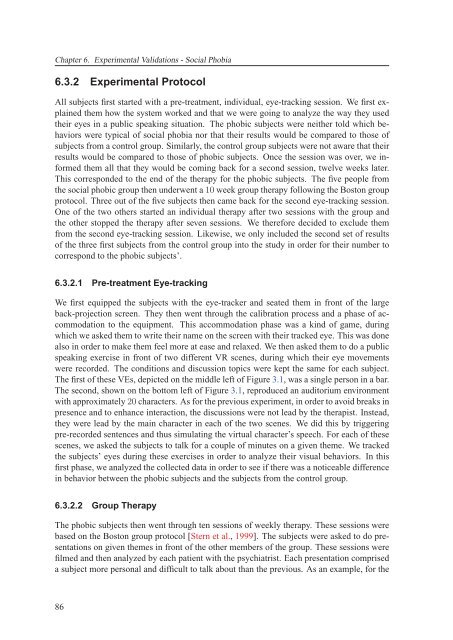Texte intégral / Full text (pdf, 20 MiB) - Infoscience - EPFL
Texte intégral / Full text (pdf, 20 MiB) - Infoscience - EPFL
Texte intégral / Full text (pdf, 20 MiB) - Infoscience - EPFL
You also want an ePaper? Increase the reach of your titles
YUMPU automatically turns print PDFs into web optimized ePapers that Google loves.
Chapter 6. Experimental Validations - Social Phobia<br />
6.3.2 Experimental Protocol<br />
All subjects first started with a pre-treatment, individual, eye-tracking session. We first explained<br />
them how the system worked and that we were going to analyze the way they used<br />
their eyes in a public speaking situation. The phobic subjects were neither told which behaviors<br />
were typical of social phobia nor that their results would be compared to those of<br />
subjects from a control group. Similarly, the control group subjects were not aware that their<br />
results would be compared to those of phobic subjects. Once the session was over, we informed<br />
them all that they would be coming back for a second session, twelve weeks later.<br />
This corresponded to the end of the therapy for the phobic subjects. The five people from<br />
the social phobic group then underwent a 10 week group therapy following the Boston group<br />
protocol. Three out of the five subjects then came back for the second eye-tracking session.<br />
One of the two others started an individual therapy after two sessions with the group and<br />
the other stopped the therapy after seven sessions. We therefore decided to exclude them<br />
from the second eye-tracking session. Likewise, we only included the second set of results<br />
of the three first subjects from the control group into the study in order for their number to<br />
correspond to the phobic subjects’.<br />
6.3.2.1 Pre-treatment Eye-tracking<br />
We first equipped the subjects with the eye-tracker and seated them in front of the large<br />
back-projection screen. They then went through the calibration process and a phase of accommodation<br />
to the equipment. This accommodation phase was a kind of game, during<br />
which we asked them to write their name on the screen with their tracked eye. This was done<br />
also in order to make them feel more at ease and relaxed. We then asked them to do a public<br />
speaking exercise in front of two different VR scenes, during which their eye movements<br />
were recorded. The conditions and discussion topics were kept the same for each subject.<br />
The first of these VEs, depicted on the middle left of Figure 3.1, was a single person in a bar.<br />
The second, shown on the bottom left of Figure 3.1, reproduced an auditorium environment<br />
with approximately <strong>20</strong> characters. As for the previous experiment, in order to avoid breaks in<br />
presence and to enhance interaction, the discussions were not lead by the therapist. Instead,<br />
they were lead by the main character in each of the two scenes. We did this by triggering<br />
pre-recorded sentences and thus simulating the virtual character’s speech. For each of these<br />
scenes, we asked the subjects to talk for a couple of minutes on a given theme. We tracked<br />
the subjects’ eyes during these exercises in order to analyze their visual behaviors. In this<br />
first phase, we analyzed the collected data in order to see if there was a noticeable difference<br />
in behavior between the phobic subjects and the subjects from the control group.<br />
6.3.2.2 Group Therapy<br />
The phobic subjects then went through ten sessions of weekly therapy. These sessions were<br />
based on the Boston group protocol [Stern et al., 1999]. The subjects were asked to do presentations<br />
on given themes in front of the other members of the group. These sessions were<br />
filmed and then analyzed by each patient with the psychiatrist. Each presentation comprised<br />
a subject more personal and difficult to talk about than the previous. As an example, for the<br />
86

















